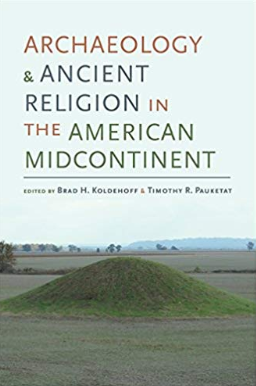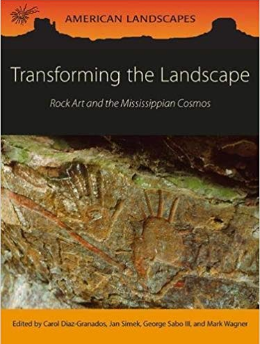Selected Books and Publications
General
The following references are overviews of Native American rock art in the Eastern United States, but some are also continental in their coverage. Annotations follow each reference.
The following references are overviews of Native American rock art in the Eastern United States, but some are also continental in their coverage. Annotations follow each reference.
-
A Survey of North American Indian Rock Art.
Wellmann, Klaus F. 1979. Akademische Druck - u. Verlansanstalt, Graz - Austria. ISBN: 3-201-01096-0
Archaeology and Ancient Religion in the American Mid-Continent Edited by Brad H. Koldehoff and Timothy Pauketat. The University of Alabama Press, Tuscaloosa.

Cave Archaeology of the Eastern Woodlands: Essays in Honor of Patty Jo Watson Edited by David H, Dye, 278 pages, University of Tennessee Press, Knoxville, 2008.

Native American Rock Art in the Eastern United States Swauger, James L. 1992. Native American Rock Art in the Eastern United States. Pennsylvania Archaeologist, 62(1):79-81.
Pictographs of North American Indians Mallery, Garrick. 1886. A Preliminary Paper, In The Fourth Annual Report of the Bureau of Ethnology, 1882-'83, pp. 13-254, edited by J. W. Powell, Government Printing Office, Washington, D.C.
Picture-writing of the American Indians – Volume 1 Mallery, Garrick. 1972. Dover Publications, Inc., New York.
Picture-writing of the American Indians – Volume 2 Mallery, Garrick. 1972. Dover Publications, Inc., New York.
Rock Art of the American Indian Grant, Campbell. 1992. Vistabooks, Dillon, Colorado. ISBN: 0-89646-084-3

Rock Art of the Eastern Woodlands Faulkner, Charles H., editor. 1996. American Rock Art Research Association Occasional Paper, No. 2, San Miguel, California.
The Rock-Art of Eastern North America Edited by Carol Diaz-Granados and James R. Duncan, with contributions from Daniel Arsenault, Mary R. McCorvie, Johannes H.N. Loubser, James R. Duncan, Carol Diaz-Granados, Richard Edging, Jan F. Simek, Steven R. Ahler, Mark J. Wagner, Fred E. Coy Jr, etc.

Transforming the Landscape: Rock Art and Mississippian Cosmos Edited by chapter by ESRARA members Carol Diaz-Granados, Jan Simek, George Sabo III, and Mark Wagner, 272 pages, Oxbow Press, Oxford, United Kingdom.

Regional
The following books will be useful to anyone seeking more detailed information about rock art within a particular geographic area of the Eastern United States. Although not a complete list, the following books are either in print or are relatively easy to obtain.
The following books will be useful to anyone seeking more detailed information about rock art within a particular geographic area of the Eastern United States. Although not a complete list, the following books are either in print or are relatively easy to obtain.
-
Alabama's Aboriginal Rock Art
Henson, Bart and John Martz. 1979. Alabama's Aboriginal Rock Art. Alabama Historical Commission, Montgomery.
Deep Cave Rock Art in the Upper Mississippi River Valley By Robert F. Bozhardt, 94 pages, Prairie Smoke Press, St. Paul, Minnesota, 2003.

Discovering South Carolina’s Rock Art By Tommy Charles, 168 pages, University of South Carolina Press, Columbia, 2010.

Indian Rock Paintings of the Great Lakes By Selwyn Dewdney and Kenneth E. Kidd, 127 pages, University of Toronto Press, Toronto, 1962.

Making Pictures in Stone: American Indian Rock Art of the Northeast By Edward J. Lenik, 251 pages, University of Alabama Press, Tuscaloosa, 2009.

Petroglyphs of Ohio Swauger, James L. 1984. Petroglyphs of Ohio. Ohio University Press, Athens. ISBN: 0-8214-0678-7
Picture Cave: Unraveling the Mysteries of the Mississippian Cosmos Edited by Carol Diaz-Granados, James R. Duncan, and F. Kent Reilly, III. 2015. University of Texas Press. ISBN: 978-0292761339

Picture Rocks: American Indian Rock Art in the Northeastern Woodlands By Edward J. Lenik, 280 pages, University Press of New England, Hanover, 2002.

Rock Art in Arkansas Edited by George Sabo III and Deborah Sabo, with contributions by Michelle Berg Vogel and Jerry E. Hilliard, 146 pages, Arkansas Archaeological Survey Popular Series 5, 2005.

Rock Art of Kentucky Coy, Fred E., Jr., Thomas C. Fuller, Larry G. Meadows, and James L. Swauger. 1997. University Press of Kentucky, Lexington. ISBN: 0-8131-1986-3

The Archaeology and Rock Art of the Piney Creek Ravine By Mark J. Wagner with photographs by Charles A. Swedlund, 124 pages, Illinois Transportation Archaeological Research Report No. 12, 2002.
The Cosmos Revealed: Precontact Mississippian Rock Art at Painted Bluff, Alabama By Jan F. Simek, Erin E. Dunsmore, Johannes Loubser, and Sierra M. Bow. 216 pages, University of Alabama Press, 2021.

The Gottschall Rock Shelter By Robert J. Salzer and Grace Rajinovich, 114 pages, Prairie Smoke Press, St. Paul, Minnesota, 2001.

The Petroglyphs and Pictographs of Missouri Diaz-Granados, Carol and James R. Duncan. 2000. University of Alabama Press, Tuscaloosa. ISBN: 0-8173-0988-8

The Prehistoric Native American Art of Mud Glyph Cave Faulkner, Charles H., ed. 1986. University of Tennessee Press, Knoxville. ISBN: 0-87049-505-4

Wisconsin Rock Art Birmingham, Robert A. and William Green. 1987. Wisconsin Archaeologist 68(4). ISSN: 0043-6364
